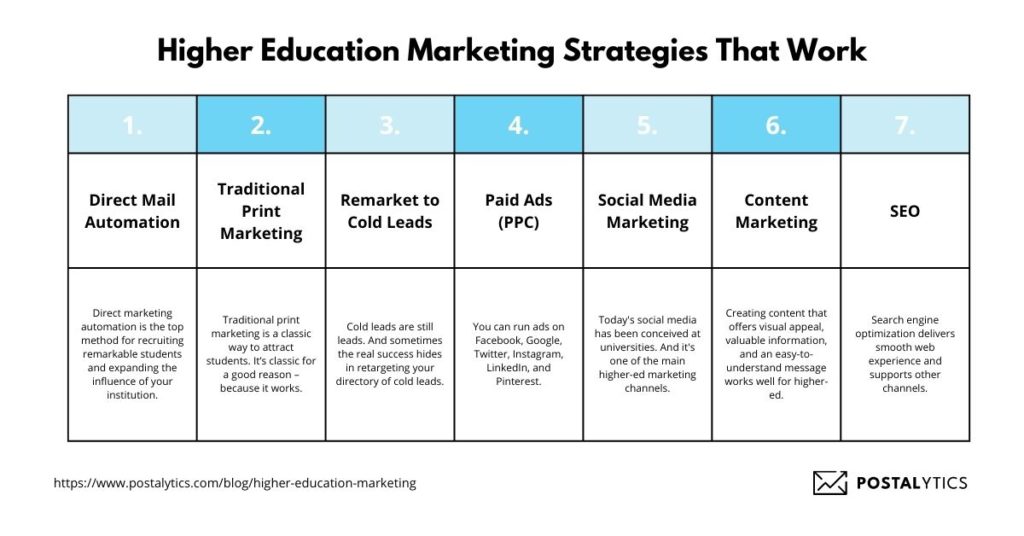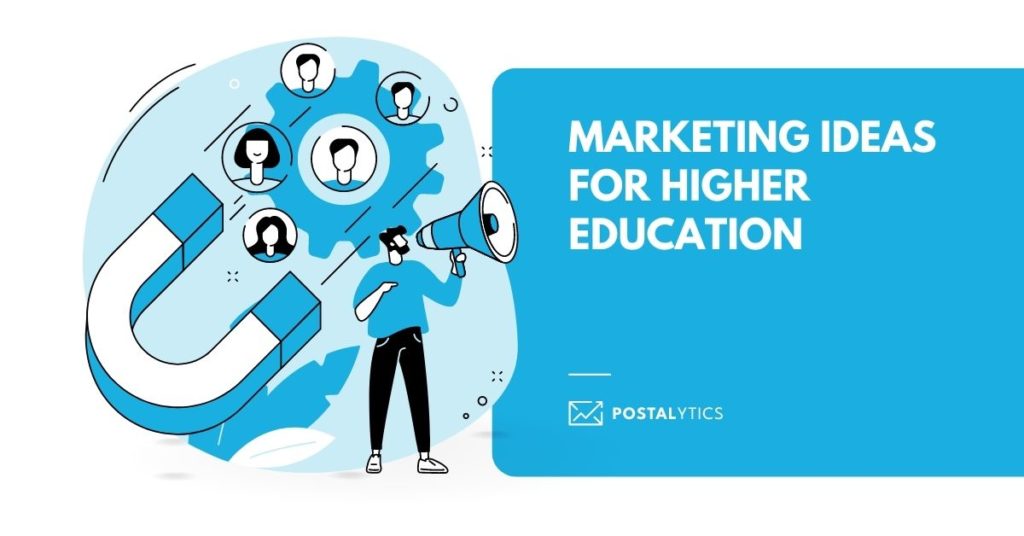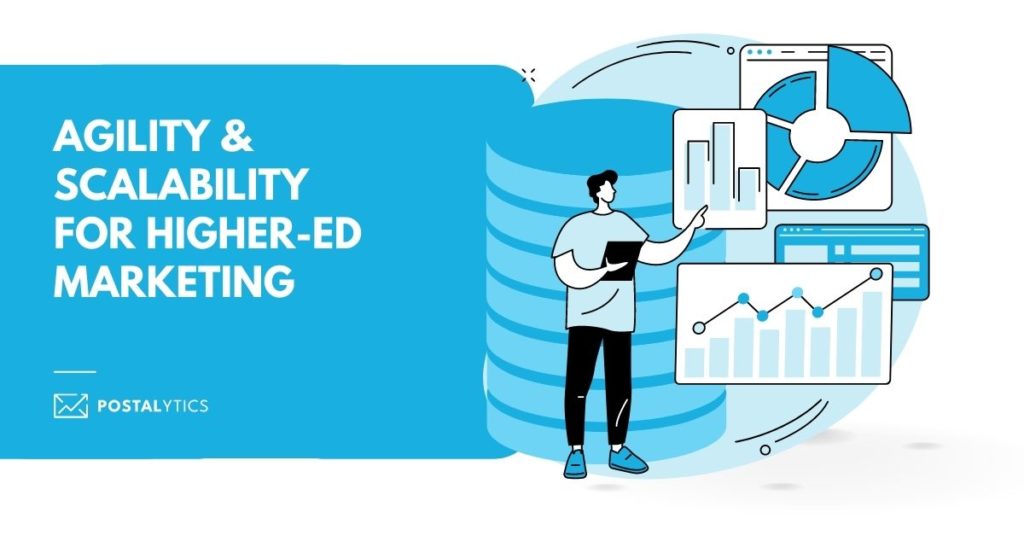
As a direct mail automation platform, we analyzed higher education marketing strategies to help you recruit exceptional students, build a timeless legacy, and reach institutional goals.
Marketing higher educational institutions are just as essential as marketing any other business. Beyond the higher number of student applications and top-quality staff, higher education marketing attracts prospective students that will one day change the world.
In the grand scheme of things, the better the students, the faster your school will reach its institutional goals. And so on. The faster the school reaches its institutional goals, the more its reputation grows. And better reputation brings better students and prominent faculty members. Every school wants to tap into this circle of perpetual growth.
But how to kick off that first domino that eventually leads to the immense growth of your institution?
Table of contents
- Higher education marketing trends and tools
- Before You Get Started
- Marketing Ideas for Higher Education
- 1. Use Direct Mail Marketing Automation
- 2. Use Traditional Print Marketing
- 3. Remarket to Cold Leads
- 4. Paid Ads (PPC) for Higher Education Advertising
- 5. Social Media for Higher Education Marketing
- 6. Content Marketing for Higher Education
- 7. Search Engine Optimization for Your Higher Education Institution
- Final Thoughts
Higher education marketing trends and tools

Using the right marketing tools helps set things in motion. Postalytics can help you execute a higher ed marketing strategy that specifically targets the right audience at the right time. This ensures that you don’t waste your marketing budget.
Postalytics marketing automation tools require less effort and time to master but ensure targeted and trackable results for direct mail marketing campaigns in higher education. For example, you can reach out to prospective students as they’re researching universities and position yourself as the best solution for their future.
To make everything simpler, you can connect your CRM with Postalytics and sync the audience’s information to create an impactful campaign. With CRM integration, you can avoid having to manually funnel information and set triggers that will automatically execute your higher education marketing campaign instead. The system prints, mails, and tracks letters at the right time. Meanwhile, you can sit back and analyze the results from the comfort of your office or home.
Want to learn more about Postalytics? Check out the demo to understand the features, tools, and user-friendly interface.
Before You Get Started
Choosing higher-ed marketing strategies based on their popularity may not be the ideal approach.
Sure, some strategies work for general promotions, but even so, they may not deliver the results you’re looking for. When creating a marketing plan for higher education, institutions need to consider some important factors. Though you should keep several things in mind while selecting marketing strategies and methods, here are two things to consider before you start building a winning strategy.
Consider Your Target Market for Higher Education
Who are you looking to target through your marketing efforts? Higher education institutions aim to target a diverse audience, such as exceptional staff, caring parents, and remarkable students.
While you can target just about every group with the same marketing plan, this approach makes things more expensive in the long run. With this plan, you may end up sending confusing messages to the audience and taint your reputation. Teachers, students, and parents may fail to connect with the information from your marketing materials. Choosing a specific audience is important to gain wanted outcomes.
Targeting the right audience in the right way will help you raise awareness of your institution and ensure better recruitment.
Consider What Their Goals and Problems Are
Once you narrow down the audience for your higher education marketing campaign, consider their goals and problems. Knowing what your audience wants will give you an edge over the competition. This way, you ensure to provide what they’re looking for.
For instance, if you’re targeting prospective students, they’re likely looking for particular extracurricular activities or specific modules that are not offered in other schools.
Now let’s say these activities are theatre classes. In that case, your college marketing strategy will revolve around how the college provides theatre classes and why it’s a good option for students’ professional development. So, when your ad pops up on social media or students receive a direct mail letter with a relevant message, it’ll prompt them to learn more about your institution. Eventually, they choose to enroll in your program.
Hence, knowing the audience’s problems, needs, and preferences is crucial to creating a targeted marketing strategy.
Marketing Ideas for Higher Education

Marketing higher education institutions is difficult if you’re trying to leverage too many channels.
For an effective strategy, you need to understand and consider several factors. And while there are plenty of marketing strategies commonly used for different businesses, here are some most effective and targeted marketing methods that can help high schools appeal to the right audience.
1. Use Direct Mail Marketing Automation
Direct marketing automation is the top method for recruiting remarkable students and expanding the influence of your institution.
Direct mail automation helps build relationships with students by investing only half the effort of traditional marketing. That’s because using personalized marketing can make recipients feel valued and seen, creating a strong emotional bond to your offer.
Implementing these marketing strategies has now become easier than ever before, so smaller institutions can rely on automating marketing campaigns at scale. Another great thing about direct mail marketing is that it allows you to measure how successful a campaign was by analyzing responses with free tracking tools.
Furthermore, there are multiple direct marketing channels that work hand in hand with direct mail automation, like email marketing and social media retargeting. This allows you to create a marketing mix that will drive your institutional goals. Of course, making the right choice requires considering where you can find talented applicants and what they prefer.
Postalytics offers direct mail automation for higher education by creating, automating, printing, shipping, and tracking your marketing campaigns. As a higher education business, all you have to do is choose an audience and then create mail using default templates and simple tools. Postalytics is an ideal option for any higher-ed school looking to attract prospective students through automated marketing systems.
2. Use Traditional Print Marketing
Traditional print marketing is a classic way to attract students. It’s classic for a good reason – because it works. Print marketing here is just a step back from direct mail automation. Think of it as the traditional way of doing things. Some schools prefer to create and mail their offers to students manually. And there’s nothing wrong with marketing your institution the old-school way.
The primary reason for direct mail advertising’s effectiveness is that it’s a tangible form of marketing. Recipients open their mail almost instantly, which can’t be said for email and other promotional channels.
Alongside the high-open rates, print mail creates a stronger emotional bond between the decision maker and the offer. When your recipient receives a letter, they feel more connected to you. This enhances student loyalty, boosts brand recognition and awareness, and improves marketing results.
Another reason to choose direct mail marketing is that it allows letter and postcard personalization, which is one of the most effective ways to attract remarkable students. Starting off your mail by addressing your customer with their name can make a great difference. Also, personalization allows you to address specific customers’ issues and give them the solution they seek.
The only downside of sending direct mail advertising is the time and effort it takes to design, print, and mail each individual letter. Personalization can take ages too. Imagine sorting 1,000s of letters and embedding each with a personalized note. It would take forever if you don’t have an enterprise-size marketing team.
Smart marketers know how to leverage all the benefits of direct mail while avoiding all the downsides. We have explained automation in the first point of this post. Postalytics offers automation and pre-built templates that will reduce the size of your marketing team and halve the time it takes to produce the entire direct mail campaign. Postalytics takes care of everything, from mail printing to shipping and tracking. Simply define triggers and let the system take care of the rest for you.
3. Remarket to Cold Leads
Cold leads are students, faculty, or parents who have shown initial interest in your offer but have gone cold since. Some have busy lives and need constant reminders. Others may want to see more from you before they make a decision. There are a gazillion reasons why leads go cold, and we can’t list all of them.
However, cold leads are still leads. And sometimes, the real success hides in retargeting your directory of cold leads. For example, you can retarget email non-responders with direct mail. One of Postalytics’ clients has boosted its ROI by including email non-responders in its direct mail campaigns.
Cold leads require effort and time before they warm up to your offer. Sometimes it’s simply a matter of creating additional touchpoints so they can interact with your offer in different formats. If you can retarget cold leads, you’ll be able to hire more qualified experts and enroll more students.
With Postalytics, you can nurture cold leads and turn them into customers through retargeting strategies. Marketers can leverage Postalytics to send direct mail at different stages of the student’s journey so they never lose sight of your institution. It also gives them the right information and message at the right time for them to make a decision. This highly strategic and targeted marketing process is a tried and true way of reaching institutional goals faster.
Let’s face it, choosing a college is one of the biggest decisions in someone’s life. Both students and parents need to know more about the potential benefits and costs before they’re ready to make such a life-changing decision.
4. Paid Ads (PPC) for Higher Education Advertising
While advertising has always been essential for businesses, it has dramatically changed in the past few decades due to the advent of social media and the proliferation of the internet. Many businesses run paid advertisements on digital platforms and search engines. You can run ads on Facebook, Google, Twitter, Instagram, LinkedIn, and Pinterest.
But why have people moved to these platforms instead of opting for standard print or broadcast advertising? That’s because more people use the internet than watch TV or read newspapers. Also, online platforms offer targeting tools. They also include customization and personalization features, so your message reaches a specific audience. You can choose demographics, people with particular interests, and age groups, among other metrics. This helps you engage with the right audience and turn them into clients.
However, online platforms are changing in the wake of recent legislation changes. Precise targeting and tracking have become more difficult and more expensive in recent months. As a result, the PPC landscape is changing, but it’s still one of the most potent advertising channels for higher education institutions.
5. Social Media for Higher Education Marketing
Higher education institutions can also benefit from social media marketing. Though social media marketing is a relatively new marketing channel, it has proven beneficial for businesses belonging to different industries, including education. This is because most audience demographics use Facebook, Instagram, Twitter, and other digital platforms for fun and entertainment or to stay connected with friends and family. Hence, using even a single platform allows you to reach a maximum number of people.
Also, with the help of social media, you can instantly spread your message to a wide audience. Once you create and run a campaign on Facebook or Instagram, it shows your message to your audience immediately. So whenever a member of the target audience, such as a student or parent, open their accounts, your ad, a story, post, or short video will pop up on their screen. If you’ve come up with a pleasing ad featuring high-quality graphics or valuable information, it prompts the audience to learn more about your high school. This will drive a decision to become a student or faculty member.
6. Content Marketing for Higher Education
Content creation works well for higher education marketing. Creating content that offers visual appeal, valuable information, and an easy-to-understand message should be your priority. You need to work on whether the content you made is for social media or direct mail.
Make videos, pamphlets, magazines, or stories based on your target audience. For instance, your content needs to be informative to engage parents, while students are more attracted to the potential career outcomes and campus life.
While content can be a big part of digital marketing campaigns, it’s just as essential for all print media.
Postalytics can help you create professionally designed newsletters, postcards, or broachers. Higher-ed marketers can create theme-based letters or postcards. They come with every option you need to create appealing and engaging content, from text format to overall letter design. The best part is that you don’t need to spend a whole day creating professional-looking content- it only takes a couple of minutes or, at most, an hour when using pre-made templates in the direct mail editor. Hence, designing marketing materials for higher education becomes easy and approachable, even for beginners.
7. Search Engine Optimization for Your Higher Education Institution
Optimizing your website to rank higher on a search engine offers long-term benefits. It’s also a vital part of most digital marketing strategies. This way, your site appears at the top whenever a student, professor, or parent looks for high schools nearby. When they see your website on top of the list, they’re bound to visit, and if you provide their desired value, they’ll contact you.
Optimizing means improving the website experience and making information highly relevant to visitors. This will help support all your other marketing efforts.
Final Thoughts

In a nutshell, higher ed marketing can help engage the audience and deliver impressive results. You can use direct mail automation, social media, paid advertisements, content, and SEO to connect with the right audience.
If you’re looking for an ideal higher ed marketing method that can offer excellent results in less time while requiring less niche-specific skills, try automating a direct mail campaign with Postalytics. We will help you design, print, mail, and track your campaign through a single dashboard.
About the Author

Dennis Kelly
Dennis Kelly is CEO and co-founder of Postalytics. Dennis joined Boingnet, the predecessor to Postalytics, in 2013. Boingnet was focused on providing print and direct mail marketing service providers the ability to add digital marketing channels to their direct mail campaigns. Postalytics is Dennis’ 6th startup. He has been involved in starting and growing early-stage technology ventures for over 30 years and has held senior management roles at a diverse set of large technology firms including Computer Associates, Palm Inc. and Achieve Healthcare Information Systems.
